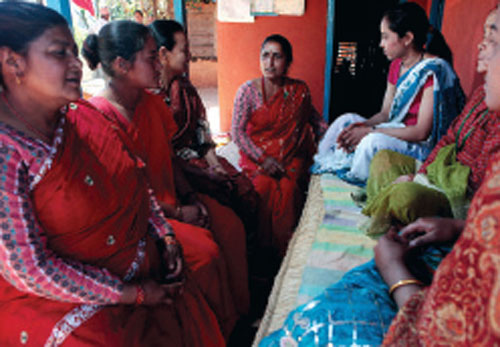
--By Gaurav Aryal
Heifer International Nepal is coming up with its 10-year strategic plan for 2014 to 2023, breaking the old rule of making five-year-plans. This new plan aims to enhance the livelihood of 500,000 households from 28 districts across Nepal. The strategic plan is in line with Heifer’s area of work – agriculture, livestock, poverty reduction and livelihood enhancement, according to Dr Shubh N. Mahato, Country Director of Heifer International Nepal.
Mahato said that the strategic plan’s final draft will be sent to Heifer Headquarters by August 2013 and will be approved by November 2013, latest. He said that it would take a fund of around USD 160 million to achieve the target of taking benefits to 500,000 families. He expects that the Heifer headquarter will approve at least 50 percent of that amount and the remaining 50 percent will be managed through local people, organisations and partners.
Heifer is actively involved in finalising the draft of the strategic plan. As a part of this exercise, it organised a consultation workshop on the first week of July with the participation of representatives from ministries, departments, and private and public stakeholders. Mahato says, “Heifer will involve more on situation analysis of the country and identify gaps in sectors where Heifer works. We will also look at government priorities in those sectors while doing situation analyses and find out areas where our strengths lie and where we can contribute best to derive optimum benefits for people.”
Embracing Change
Unlike in the past, Heifer has now decided to formulate long term strategies with a special focus on programmes, and each project under a specific programme will work with at least 1000 households. The organisation used to make projects that catered to a relatively small number of families ranging from 50 to 500. Mahato says such practices made reporting, compilation and monitoring of projects difficult and also added extra managerial cost. “So, the headquarter put forward the concept of programmes. However, the Nepal office was working in an almost similar manner even before the new approach was adopted by the headquarter.”
 Making Impact
Making Impact Heifer continues to work on poverty reduction, food security, livelihood enhancement, agriculture and livestock sectors. “We ensure that a poor family is brought above the poverty line through our projects. We also take those families to a point where any shock would not push them back again into poverty,” he explains. Heifer helps local people enhance their capacity so that they can work towards making them better off than in the past. The projects of Heifer are implemented by local NGOs. Heifer distributes animals and commodities to produce milk, eggs, ploughing power and other benefits so that families can afford nutrition, education for children, health care and improved housing resulting to an enhanced livelihood.
According to Mahato, the ongoing projects of Heifer are being implemented in 28 districts. He hints that the new programmes and projects will be implemented in these districts along with new ones based on the suitability and potential of projects such as dairy and goat farming. While selecting an area for project implementation, Heifer takes into account the level of poverty, people’s needs and the feasibility of its projects. Mahato says that every household is benefitted out of Heifer projects and all of them need not necessarily live below the poverty line.

Reducing Duplication
Starting April 2012, Heifer has adopted a new strategy to implement projects under the ownership of VDCs so that the issue of duplication can be resolved. “We ensure that the projects are not owned by Heifer or an NGO but by a particular VDC where the projects and sub-projects are targeted. For that, out of the total size of the project, 25 percent must be contributed by the VDC. As the VDC is handed over responsibilities for project implementation, they will merge similar projects with similar targets by other organisations,” he says. So far, 44 VDCs are already implementing projects under this model. Mahato says that this approach has helped in reducing the duplication of projects.
 Ongoing Projects
Ongoing Projects Currently, a project of USD 23.4 million is in its implementation phase. This programme targets a total of 138,000 households in 28 districts. According to Mahato, the project has already reached 68,207 households including 12,089 new families and 56,118 families through Heifer’s approach of ‘Passing on the Gift’ under which direct recipient families pass on resources ranging from livestock, improved seeds to skills and knowledge to more needy families. Similarly, the ongoing project has also benefitted 20,000 cooperatives. As of now, 88,207 beneficiaries have been benefitted through Heifer within a period of one and a half years. Mahato says, “Project implementation started with at least 50 percent of the targeted households and we are satisfied with the progress we have made.”
Of the total USD 23.4 million funds, 25 percent was raised by Heifer internally. Mahato says, “When the Heifer headquarters asked us to raise 25 percent of the total fund, we were in doubt as we had never done anything like that in the past. Surprisingly, we were able to collect 44 percent of that amount and we are confident that we can successfully meet the targets for future programmes.”
Heifer claims that 92,000 households are directly benefitted by its projects since its establishment. Mahato says that an initial projects of Heifer in 1993 –Buruwa Goat Raising Project for a group of 25 women in Gitanagr VDC in Chitwan district - is still benefitting people through the model of passing on the gift. Heifer has been working in Nepal since 1993 and established a country office in September 1997. Heifer International in 1957, for the first time had sent shipments of cattle, pigs, sheep and parent stock of poultry at the Nepal government’s request in order to introduce high yielding livestock.





















